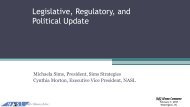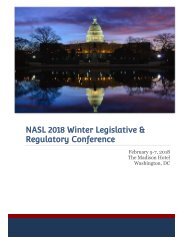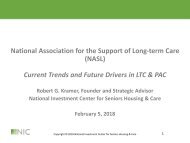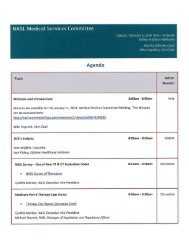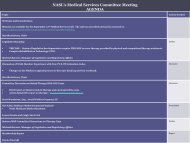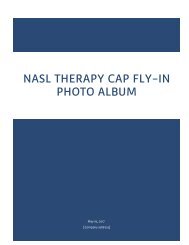Home health update for Medical Services Committee - Mason
- No tags were found...
You also want an ePaper? Increase the reach of your titles
YUMPU automatically turns print PDFs into web optimized ePapers that Google loves.
1<br />
HOME HEALTH UPDATE<br />
PPS REFORM RESEARCH; NEW COPS<br />
NASL Conference February 7, 2017<br />
Sherill <strong>Mason</strong><br />
<strong>Mason</strong> Advisors LLC<br />
NASL 2017 Winter Conference
2<br />
BACKGROUND<br />
• The home <strong>health</strong> PPS has not been significantly revised since it took effect in<br />
2000<br />
• Much as in SNFs, payments are based on<br />
• The degree of functional impairment of a person<br />
• Clinical complexity<br />
• Volume of therapy visits<br />
• The payment system has been criticized as having a perverse incentive to<br />
over-utilize therapy while not paying enough <strong>for</strong> clinically complex care<br />
• CMS engaged a contractor to study PPS and in December, 2016 the<br />
contractor released a detailed technical report<br />
NASL 2017 Winter Conference
3<br />
CURRENT HOME HEALTH PPS<br />
• Today, home <strong>health</strong> agencies are reimbursed <strong>for</strong> 60 day episodes of care<br />
• Agencies are reimbursed separately <strong>for</strong> non-routine medical supplies as well as<br />
disposable negative pressure wound therapy devices<br />
• There is no limit to the number of episodes a person can receive, but the<br />
average number of episodes per beneficiary is 1.9<br />
• There is no copayment or deductible<br />
• The first two 60 day episodes are considered “early” and are reimbursed at<br />
higher rates than “late” episodes<br />
• There are 153 different HHRGs<br />
• HHRGs are determined based on in<strong>for</strong>mation from the OASIS<br />
• Payments <strong>for</strong> episodes with four or fewer visits are considered LUPAs and are<br />
reimbursed on a per-visit basis<br />
NASL 2017 Winter Conference
4<br />
HHGM MODEL<br />
• The <strong>Home</strong> Health Grouping Model (HHGM) would eliminate therapy<br />
thresholds in determining payments<br />
• HHGM would group episodes into clinical groups that describe the purpose<br />
of the episode<br />
• HHGM would use OASIS and non-OASIS items in the case mix system<br />
• HHGM measures resource use using a cost-per-minute approach, combining<br />
the non-routine supply payment with the episode payment<br />
NASL 2017 Winter Conference
5<br />
HHGM MODEL<br />
• Under HHGM there would be two 30 day periods within each 60 day episode<br />
• Only the first 30 day period would be considered “early,” receiving a higher<br />
reimbursement rate than “late” periods<br />
• Admission source would be a factor in rates, with admissions from institutional<br />
settings reimbursed at higher rates than admissions from the community<br />
• There would be six clinical groupings, including:<br />
• Musculoskeletal rehabilitation<br />
• Neuro/stroke rehabilitation<br />
• Wounds<br />
• Medication management, teaching and assessment (MMTA)<br />
• Behavioral <strong>health</strong><br />
• Complex nursing interventions<br />
NASL 2017 Winter Conference
6<br />
HHGM MODEL<br />
• There would be two or three functional levels<br />
• For patients in the behavioral <strong>health</strong> or musculoskeletal rehab categories, there<br />
would be two levels, low or high<br />
• For patients in other clinical groups, functional levels would be low, medium and<br />
high<br />
• There would be two comorbidity adjustment groups, including yes or no,<br />
based on secondary diagnoses<br />
• In total, there would be 128 possible different payment groups<br />
NASL 2017 Winter Conference
7<br />
RESEARCH FINDINGS; ADDITIONAL DETAIL<br />
• A wide variation exists in the length of episodes<br />
• Variation is related to the admission source and the reason <strong>for</strong> receiving home <strong>health</strong><br />
• The average length of an episode was 46.1 days<br />
• Admissions from the community had an average length of 49.1 days<br />
• Admissions with a hospital stay within 7 days prior to admission had average stays <strong>for</strong> 37.8 days, but<br />
varied by DRG<br />
• LEJRs had an average length of 23.7 days<br />
• The following OASIS items are used in the model to determine functional status<br />
• M1800: Grooming<br />
• M1810: Current ability to dress upper body<br />
• M1820: Current ability to dress lower body<br />
• M1830: Bathing<br />
• M1840: Toilet transferring<br />
• M1850: Transferring<br />
• M1860: Ambulation and locomotion<br />
• M1032: Risk <strong>for</strong> hospitalization<br />
NASL 2017 Winter Conference
8<br />
HHGM MODEL DETAIL<br />
• Abt created 13 broad clinical categories with 116 subcategories to determine<br />
comorbidity adjustments. These include<br />
• Heart disease (11)<br />
• Respiratory disease (9)<br />
• Circulatory disease and blood disorders (12)<br />
• Cerebral vascular disease (4)<br />
• Gastrointestinal disease (9)<br />
• Neurological and associated conditions (11)<br />
• Endocrine disease (6)<br />
• Neoplasms (24)<br />
• Genitourinary and renal disease (5)<br />
• Skin disease (5)<br />
• Musculoskeletal disease or injury (5)<br />
• Behavioral <strong>health</strong> (11)<br />
• Infectious diseases (4)<br />
NASL 2017 Winter Conference
9<br />
IMPACT ON PAYMENT RATES<br />
• The average 30 day payment under today’s PPS and HHGM would be the<br />
same at $1,519.22<br />
• The new model pays more at the lower-center of distribution and less <strong>for</strong> the<br />
upper portion of distribution<br />
• For example, payments <strong>for</strong> the 50 th percentile would be $1,325.18 under current<br />
PPS vs. $1,435.43 under HHGM<br />
• Payments <strong>for</strong> the 95 th percentile would be $2,767.26 under current PPS and<br />
$2,476.01 under HHGM<br />
• On average, facility-based HHAs would see a 15% increase while<br />
freestanding would see a decline of -1.5%<br />
• Non-profits would see an average increase of 12.9% while <strong>for</strong>-profits would<br />
see an average decline of -4.7%<br />
NASL 2017 Winter Conference
PAYMENTS FOR THERAPY EPISODES WOULD<br />
DECLINE IN FAVOR OF COMPLEX NURSING<br />
EPISODES<br />
• Episodes without therapy would see average increases of 25%, while therapy<br />
episodes would see an average decline of -10%<br />
• Episodes with admissions from institutional settings would see average<br />
increases of 29.5%, while episodes with admissions from the community<br />
would decline an average of -15%<br />
• Episodes falling into the Behavioral Health category would have reduced<br />
payments of 10%<br />
• Episodes in the Wound category would have increased payments of 25% to<br />
nearly 30% while Complex Nursing Intervention episodes would have<br />
average increases of 14% to 18%, depending on the degree of functional<br />
impairment<br />
10<br />
NASL 2017 Winter Conference
11<br />
HOME HEALTH<br />
Conditions of Participation<br />
NASL 2017 Winter Conference
12<br />
NEW COPS ARE HERE<br />
• On January 9, 2017, CMS released the final rule revising the home <strong>health</strong><br />
conditions of participation <strong>for</strong> the first time in 20 years<br />
• The new CoPs become effective July 13, 2017<br />
• The estimated cost to providers <strong>for</strong> the first year of implementation is $293.3M,<br />
and $290.1M per year thereafter<br />
• It is possible the new administration will review the rule and could either cancel<br />
or delay implementation<br />
• Overall, the industry response was neutral to positive<br />
• NAHC published an excellent cross-walk on their website<br />
www.nahc.org<br />
NASL 2017 Winter Conference
13<br />
NEW COPS<br />
• Much of the work done on the CoPs was to re-organize existing CoPs in a more<br />
sensible manner<br />
• Certain items were <strong>update</strong>d to reflect current technology<br />
• On a broad basis, the CoPs are more patient-directed than be<strong>for</strong>e<br />
• Requirements were added to communicate in the patient’s primary or preferred<br />
language; the patient has a right to participate in the development of the plan of<br />
care, including receiving a copy of the plan and receiving all services included in<br />
the plan of care<br />
• The CoP requiring HHAs that provide outpatient therapy to meet all of the related<br />
conditions and <strong>health</strong> and safety requirements was changed from a CoP to a<br />
standard<br />
• Rather than having separate standards <strong>for</strong> therapists and nurses, skilled professionals<br />
are grouped together in their responsibilities related to assessment, development<br />
and updating plans of care, the provision of services, counseling and education,<br />
preparing clinical notes, participating in QAPI and communicating with physicians<br />
NASL 2017 Winter Conference
14<br />
QUESTIONS?<br />
Thank you so much!<br />
Sherill <strong>Mason</strong>, Principal, <strong>Mason</strong> Advisors LLC smason@masonadvisors.com<br />
NASL 2017 Winter Conference




